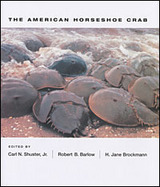
The American horseshoe crab that comes ashore on the East Coast in vast numbers to mate and nest is much the same creature that haunted the coast before the time of the dinosaurs. It is among the world's most intensely studied marine invertebrates, critical to our understanding of many groups of organisms, both modern and extinct, and crucial to the ecology of large estuaries such as the Delaware Bay. Some stocks of this great survivor, whose ancestors made it through the mass extinction some 286 million years ago, have been severely depleted today because of overfishing and habitat destruction.
Carl N. Shuster, Jr., H. Jane Brockmann, and Robert B. Barlow are at the forefront of research on Limulus polyphemus, and in this book they bring together twenty scientists who have worked on all aspects of horseshoe crab biology to compile the first fully detailed, comprehensive view of the species. An indispensable resource, the volume describes the horseshoe crab's behavior, natural history, and ecology; its anatomy, physiology, distribution, development, and life cycle; the puzzle of its immune system; and its present management and future conservation.

At the 1988 summer session, the internationally famous Marine Biological Laboratory (MBL) at Woods Hole, Massachusetts celebrated one hundred years of pioneering science. During the centennial festivities, many of the world's most renowned biologists assembled at MBL and delivered the Lab's traditional Friday Night Lectures, which as always were extraordinary and memorable. These lectures have been gathered and judiciously edited here by three eminent participants.
Each centennial lecture is dedicated to one or two MBL pioneers, investigators at the forefront of the "new biology" that emerged toward the turn of the century. The MBL often provided an environment that was conducive to revolutionizing the discipline, replacing its largely descriptive and speculative methods with lively analytical and experimental science.
Combining history and current science, each lecture focuses on a subfield of biology. The speakers represented include John Gurdon on developmental biology, Joshua Lederberg on genetics, Torsten Wiesel on neurobiology, and E. 0. Wilson on animal behavior. Benjamin Kamminer provides an account of the work of Albert Szent-Györgyi, capturing his iconoclastic, tenacious, sometimes outrageous nature, as well as his humor and insight. And Gerald Weissmann compares Jacques Loeb and Gertrude Stein--an unlikely pair bound by their common assent to mechanistic materialism.
The history and scientific discovery in these pages should convey for any reader whether biologist, historian, or interested layperson--the excitement of the renowned laboratory and the drama and frustration of biology in the twentieth century.
READERS
Browse our collection.
PUBLISHERS
See BiblioVault's publisher services.
STUDENT SERVICES
Files for college accessibility offices.
UChicago Accessibility Resources
home | accessibility | search | about | contact us
BiblioVault ® 2001 - 2024
The University of Chicago Press









